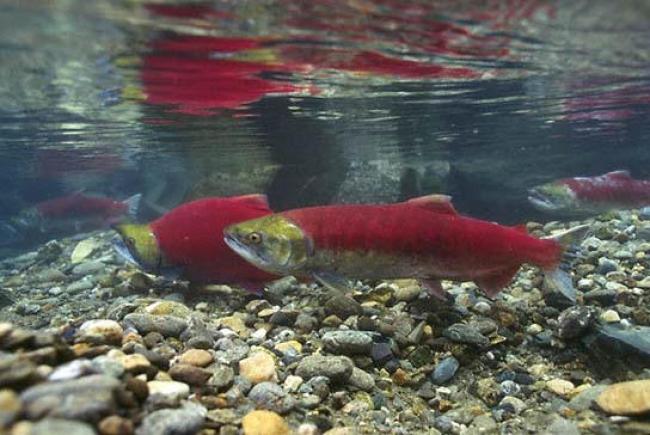(A recap of DFO’s annual State of the Salmon assessment)
Many factors contribute to the decline of wild salmon in B.C. Habitat destruction, harvest, and bad aquaculture practices are all negative impacts, but the effect global warming has on salmon populations will be widespread, long-lasting and irreversible without urgent action.
DFO recently released a preliminary report on predicted salmon returns for 2021. You can read a summary of the report by fisheries expert Greg Taylor here, but, in general, many salmon runs across the province have been in decline and 2021 isn’t expected to be any different. But, unprecedented environmental conditions are making predictions of salmon returns in recent years more difficult to make.
Every year, DFO’s State of the Salmon Program collects research on environmental changes from a variety of sources to better understand and inform salmon return predictions for the following year. They recently presented on the current environmental conditions and the implications for wild salmon in 2021. Read a recap of the presentation below.
Increasing global temperatures and changes in precipitation = warmer waterways
Research shows global air temperatures are trending hotter than expected in recent decades. Five of the last six years were the hottest on record. The situation gets more dire as you move closer to the north pole, as temperatures are increasing more rapidly than they are at the equator. Warmer air temperatures globally lead to warmer water temperatures locally and for species, including salmon, that thrive in colder waters, this is very harmful.
In B.C., global warming is contributing to smaller snowpacks. A smaller than average snowpack means lower than average flow in rivers and streams and in turn, higher water temperatures.
B.C. is also experiencing drier summers, with less precipitation, leading to a similar bad outcome for salmon; less flow and water that gets warmer, faster.
While temperatures above 25 degrees will kill salmon, temperatures above 18 degrees alter the behaviour of adult salmon, making it harder for them to swim, escape predators and dig their nests. Warm waters also impair salmons’ immune systems, making it harder for them to survive the effects of viruses and other pathogens.
In some cases, lack of precipitation can also result in some sections of streams or rivers drying up, leaving fish stranded in small pools of water and unable to migrate.
Record-setting forest fires are degrading spawning habitat
2017 and 2018 were both record-setting forest fire years in the province. Where these fires occur, the lack of tree cover and changes to soil results in increased runoff, slope instability, and erosion, all contributing to more sediment entering streams. This negatively affects salmon spawning habitat by covering spawning gravels and smothering redds (salmon nests).
Forest fires also destroy riparian vegetation. Without riparian vegetation to shade waterways, stream temperatures increase even more and further stress wild salmon.
More landslides, more disconnected habitat
Global warming is also thought to be increasing the occurrence of landslides. This has the potential to block access for salmon to their spawning grounds and can have a huge impact on specific runs.
Ocean conditions: the good, the bad, and the blob
Things aren’t just changing for salmon in their freshwater environments; marine conditions are also changing. The bad news? Oceans are absorbing much of the excess heat resulting from a warming climate. Even with intervention to address climate change, it will take some time for these expansive water bodies to drop in temperature. Increased ocean temperatures are thought to reduce overall ocean productivity and change the availability of different zooplankton, a primary food source for salmon. Larger, fattier zooplankton are being replaced by smaller, less nutritious species, and fewer of them, meaning there is less, and lower quality food for salmon in the ocean. Underfed and smaller fish don’t have the same energy stores to make the trip back to their spawning grounds. At the same time, wild salmon are having to compete with growing numbers of hatchery fish for these dwindling food supplies.
The west coast has also been home to “the blob” off and on since 2013. The blob is a patch of ocean stretching from California to Alaska with water temperatures even higher than the rest of the (warming) Pacific. The good news is that the recent presence of La Niňa, a period of cooler water temperatures in the south, will likely help to mitigate the warmer waters of the blob, and also increase precipitation locally, which will be beneficial to salmon in their freshwater habitat as well.
What’s our take-away?
Clearly, a changing climate is making freshwater and marine habitat less hospitable to wild salmon. Though they are resilient, how much closer to the brink can we push them before there is no coming back? While climate change is a global issue, we need our governments to step up and invest in salmon-friendly renewable energy and reduce rather than expand our production and use of harmful fossil fuels like oil and fracked gas. We need to swiftly tackle the threats to salmon that we have immediate control over. That means protecting, restoring and reconnecting key habitats (an investment that will also create jobs and support local economies), getting salmon farms out of the water, safer approaches to fishing and hatchery production, and better monitoring so we can understand the current status of different salmon populations.

